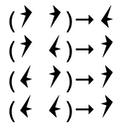Quotes
We know that consciousness and infinity exist "inside" our minds. But we have no
objective way of knowing if they exist "outside" of our minds. There is no objective
measure for consciousness; there is no objective measure for infinity (there are no
rulers of infinite length, or clocks of endless time, for example).
The theist claims that there exists a mind that is both conscious and infinite and
calls this mind God.
The theologian or philosopher who attempts to prove the objective existence of God
is thereby engaging in a futile effort, as is the effort to disprove said existence.
The atheist who asks for objective proof of God is making a category error.
-- wrf3
That's Judsonia
The first is a picture of a steamboat on the Little Red River [click picture for a larger version].
Jimmy Gill, and his brother W. W. "Doc" Gill lived across the street from my grandmother's house. Jimmy framed pictures, Doc was a dentist. One summer, very long ago, my dad and I were outside the house when Doc — a very old man at the time — came shuffling up the sidewalk. Dad asked, "Why don't you let Doc look at your loose tooth?" Of course I didn't want him too. But dad and Doc convinced me to open my mouth and, before I could react, Doc snaked his gnarly old forefinger into my mouth and the tooth was out. That should have been the beginning of a deep-seated mistrust of doctors, but my dad and Doc knew what they were doing. The tooth was out and the extraction didn't hurt. But how times have changed. Today an ungloved hand wouldn't go near a patients mouth.
The second article features Orr's reflections on his book. The third article recounts a Yankee gunboat on the Red River during the war of Northern aggression. The links go to digitized versions of the articles; the page titles link to the scan of the article.
The Inner Mind
[Similar introductory presentation here]
Philosophy of mind has the problem of "mental privacy" or "the problem of first-person perspective." It's a problem because philosophers can't account for how the first person view of consciousness might be possible. The answer has been known for the last 100 years or so and has a very simple physical explanation. We know how to build a system that has a private first person experience.
Let us use two distinguishable physical objects:

These shapes of these objects are arbitrary and were chosen so as not to represent something that might have meaning due to familiarity. While they have rotational symmetry, this is for convenience for something that is not related to the problem of mental privacy.
Next, let us build a physical device that takes two of these objects as input and selects one for output. Parenthesis will be used to group the inputs and an arrow will terminate with the selected output. The device will operate according to these four rules:

A network of these devices can be built such that the output of one device can be used as input to another device.
It is physically impossible to tell whether this device is acting as a NAND gate or as a NOR gate. We are taught that a NAND gate maps (T T)→F, (T F)→T, (F T)→T, and (F F)→T; (1 1)→0, (1 0)→1, (0 1)→1, (0 0)→0 and that a NOR gate maps (T T)→F, (T F)→F, (F T)→F, (F F)→T; (1 1)→0, (1 0)→0, (0 1)→0, (0 0)→1. But these traditional mappings obscure the fact that the symbols are arbitrary. The only thing that matters is the behavior of the symbols in a device and the network constructed from the devices. Because you cannot tell via external inspection what the device is doing you cannot tell via external inspection what the network of devices is doing. All an external observer sees is the passage of arbitrary objects through a network.1
To further complicate the situation, computation uses the symbol/value distinction: this symbol has that value. But "value" is just elements of the alphabet and so are identical to symbols when viewed externally. That means that to fully understand what a network is doing, you have to discern whether a symbol is being used as a symbol or as a value. But this requires inner knowledge of what the network is doing, which leads to infinite regress. You have to know what the network is doing on the inside to understand what the network is doing from the outside.
Or the network has to tell you what it's doing. NAND and NOR gates are universal logic gates which can be used to construct a "universal" computing device.2
So we can construct a device which can respond to the question "what logic gate was used in your construction?"
Depending on how it was constructed, its response might be:
- "I am made of NAND gates."
- "I am made of NOR gates."
- "I am made of NAND and NOR gates. My designer wasn't consistent throughout."
- "I don't know."
- "What's a logic gate?"
- "For the answer, deposit 500 bitcoin in my wallet."
Before the output device is connected to the system so that the answer can be communicated, there is no way for an external observer to know what the answer will be.
All an external observer has to go on is what the device communicates to that observer, whether by speech or some other behavior.3
And even when the output device is active and the observer receives the message, the observer cannot tell whether the answer given corresponds to how the system was actually constructed.
So extrospection cannot reveal what is happening "inside" the circuit. But note that introspection cannot reveal what is happening "outside" the circuit. The observer doesn't know what the circuit is doing; the subject doesn't know how it was built. It may think it does, but it has no way to tell.
[1] Technology has advanced to the point where brain signals can be interpreted by machine, e.g. here. But this is because these machines are trained by matching a person's speech to the corresponding brain signals. Without this training step, the device wouldn't work. Because our brains are similar, it's likely possible that a speaking person could train such a machine for a non-vocal person.
[2] I put universal in quotes because a universal Turing machine requires infinite memory and this would require an infinite number of gates. Our brains don't have an infinite number of neurons.
[3] See also Quss, Redux, since this has direct bearing on yet another problem that confounds philosophers, but not engineers.
Quotes
The essence of Christianity is not doctrine any more than the essence of physics
is the formulas. Christianity is, first and foremost, hearing the music of heaven and
being so enthralled that you can't help but join in the dance.
-- wrf3
You can go from experience to reason about the experience.
But you cannot go from reason to experience.
No philosophical argument ever made anyone see the beauty
in a sunrise, taste the crispness of an apple, or cause a
sneeze.
So it is with God.
-- wrf3
The first quote was born after my morning walk/run while drying off afterward. I still had my AirPods in when a certain song by Fall Out Boy so captured my imagination that I started dancing in front of the mirror. It wasn't a pretty sight by any stretch of the imagination, but the Spirit blows where it will.
The second follows from the first, especially after reading "Apologetics Beyond Reason" by James. W. Sire, which greatly - and far more ably - expresses this than I ever could.


